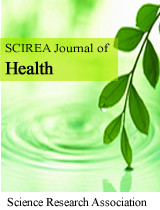POISONINGS IN CHILDREN
DOI: 314 Downloads 16037 Views
Author(s)
Abstract
AbstractIntroduction: The poisoning problem is acute, complex and multifaceted. The child poisoning is dangerous and may jeopardize their lives.Purpose: the present literature retrospective study was to list information about the poisoning in pediatric patients.Methodology: The study material has recently been articles on the topic were found mainly in the electronic database Medline and the Association of Greek Academic Libraries (HEAL-Link).Results: The poisonings in children occur at home, especially in the kitchen, at school and in the countryside. Poisoning of a child, usually when there are symptoms like restlessness, disturbances of consciousness, hallucinations, convulsions, bleeding, vomiting and diarrhea or skin lesions.Conclusions: Parents or caregivers of children need to know about the poisoning, the signs and symptoms, prevention and what to do when the child presented intoxication.
Keywords
poisoning, children, prevention and treatment
Cite this paper
Lambrini Kourkouta, Christos Iliadis, Alexandros Monios, Petros Ouzounakis,
POISONINGS IN CHILDREN
, SCIREA Journal of Health.
Volume 2, Issue 2, April 2017 | PP. 5-12.
References
| [ 1 ] | C. Iliadis, A. Monios, L. Kourkouta, Pharmaceutical Poisonings. Monograph. Lap Lambert Academic Publishing. Saarbrucken, Germany (2014). |
| [ 2 ] | K. Paulidou, Research on the necessity of First Aid training of kindergarten teacher. Writing of a First Aid manual for kindergarten teachers. Thesis. Department of Early Childhood. Pedagogy Florina School. University of Western Macedonia. Florina (2016). |
| [ 3 ] | D. Trichopoulos, V. Kalapothaki, E. Petridou, Preventive Medicine and Public Health. Athens: Eds Zita (2000). |
| [ 4 ] | F. Georgiakodis, A. Voziki, The epidemiology of school accidents: Conclusions from research in secondary schools. Proceedings 17th Panhellenic Statistics Conference. Greek Statistical Institute. (2004) 83-92. |
| [ 5 ] | National Action Plan Training Study on Health Education in Primary and Secondary Education students (2008). |
| [ 6 ] | C. Baltopoulos, First Aid. Athens: Medical Publications P.Ch. Paschalidis (2001). |
| [ 7 ] | H. Karutz, M. Von Buttlar, E.H. Kursbuch, Greek Edited Kourkouta L. Athens: Scientific Publications Parisianou SA (2005). |
| [ 8 ] | Ch. Kougioumtzoglou, (2006) First Aid. Available in http://protesbohthies.blogspot.com |
| [ 9 ] | Y. Holder, M. Peden, E. Krug, J. Lund, G. Gururaj, O. Koibusingye, Injury Surveillance Guidelines. Geneva: World Health Organization (2001). |
| [ 10 ] | F.M. Cleugh, Maconochie IΜ Injury prevention in children. Current Paediatrics 15 (2005) 569–574. |
| [ 11 ] | K.H. Tsoumakas, Children accidents. Athens: Medical publications BC Pashalidis (2006). |
| [ 12 ] | M. Papastamatiou, Fundamentals in providing First Aid. Athens: C. Parisianou (2011). |
| [ 13 ] | S. Ziakas, et all Analysis of child poisonings type accidents. Clinical-epidemiological study, Pediatrics Northern Greece. 15 (2003) 154-158. |
| [ 14 ] | A. Petridis, E. Eftychidou, First Aid. Broken hill Publishers ltd, Athens. |
| [ 15 ] | Ch. Tripodis, A. Christakis, P. Psychogiou, N. Tripodis, (2009) Accident-First aid at school. Available in http://2pek.att.sch.gr/Dhmosieuseis-arthra.htm |
| [ 16 ] | E. Petridou, Department of Hygiene and Epidemiology, University of Athens Medical School, Research and Accident Prevention Centre (CPC) Accidents: Principles of Public Health and Preventive Medicine (2005). |
| [ 17 ] | L.I. Tsouskas, First Aid. University Studio Press SA, Thessaloniki (2001). |
| [ 18 ] | P. Soukouli, (2001) Health / First Aid: Poisoning, available in www.iatronet.gr. |
| [ 19 ] | X. Dedoukou, T. Spyridopoulos, S. Kedikoglou, D.M. Alexe, N. Dessypris, E. Petridou, (2004) Incidence and Risk Factors of Fall Injuries Among Infants, Arch Pediatr Adolesc Med. 158 (2004) 1002-1006 |
| [ 20 ] | N. Gkourtsas, First Aid. Thessaloniki:Publications Burgos I (2013). |

